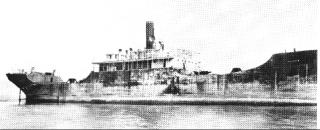 Experiment
with Buoyancy
Experiment
with Buoyancy
 Experiment
with Buoyancy
Experiment
with Buoyancy
How does a ship float? Well, some ships are made of wood, and wood floats, so in that case is easy to understand. What about ships made of heavy steel, though? Or the concrete ships (above) that were constructed during a steel shortage at the end of WWI? Steel and concrete are heavier that water, how do they float?
A ship will float as long as it weighs less than the water it pushes out of way, or displaces. Ships can use materials in their hulls that are heavier than water, but there must be air within the ship. Since the air doesn't weigh as much as the water, this lowers the weight of the ship compared to the same volume of water. Try this experiment to see how trapping air in a ship can make it float. You will need a lump of clay and a sink filled with water.
 STEP 1 - Roll
the clay into a ball and place it in the sink. Does it
float?
It shouldn't because the clay weighs more than the water.
STEP 1 - Roll
the clay into a ball and place it in the sink. Does it
float?
It shouldn't because the clay weighs more than the water.
STEP 2 - Now shape the clay into a rounded cup and put a small lump on the bottom as a keel. Put it in the water with the open part of the cup facing up so it stays filled with air. Does it sink? It shouldn't. As long as the bowl of the cup is large enough and contains air the clay will float. This is because the air makes the clay ship weigh less than the water it displaces.
STEP 3 - Now fill the bowl of the cup with water. Does it sink? It should. When the bowl is filled with water the clay ship weighs more than the water it displaces and sinks.
When a ship floats it is said to have positive buoyancy. When it sinks it has negative buoyancy.
For another buoyancy experiment try the pencap submarine.
Copyright Lee Krystek 1999. All Rights Reserved.